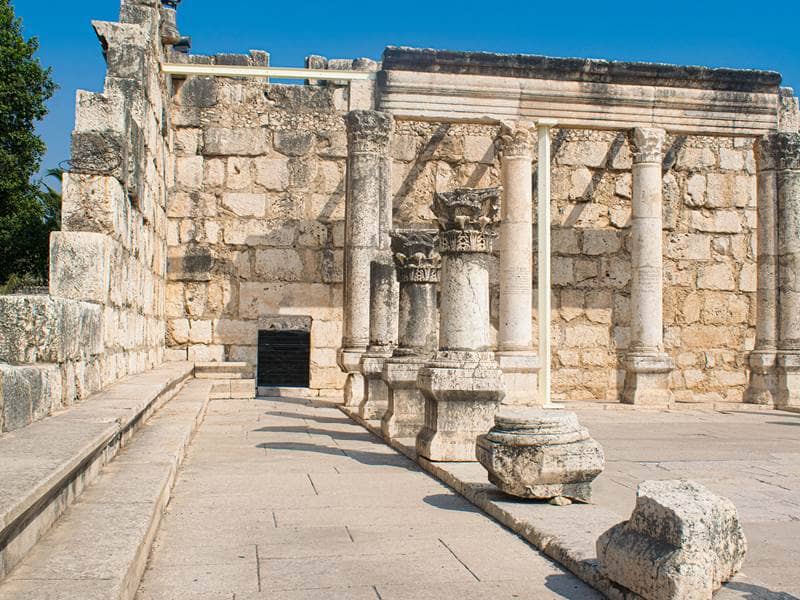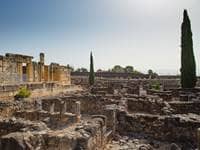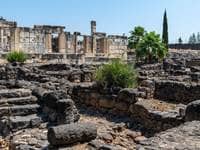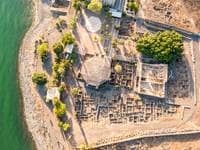
- Trending:
- History
- |
- Forgiveness
- |
- Marriage
- |
- Parenting
- |
- Suffering
- |
- Resurrection





Associated Faiths:
Accessibility:
Open to visitors.
Annual Visitors: 2,000,000
History
The fishing village of Capernaum (located on the northern shore of the Sea of Galilee) gets its name from the Hebrew, Kefar Nahum—which means “village of Nahum.” Capernaum is believed to be the burial place of the Jewish prophet, Nahum (circa 7th century BCE). In addition to Nahum’s remains being interred there, the Christian Apostle Peter is also said to have been born in Capernaum—and Jesus made it the “headquarters” per se of His Galilean ministry.
The village has been continuously occupied since at least the 2nd century BCE and down through the 11th century CE. It appears to have been abandoned around the time of the first Christian Crusade (AD 1096-1099). While it was largely an Arab settlement (known as al-Samakiyya) from the 8th CE century until the 1947-1948 war, at that time the Arab Palestinian population was required to relocate.
According to the Bible, the synagogue in Capernaum was an important focal point for the ministry of Jesus. It was the location of both His teaching ministry and His healing ministry. While that original synagogue no longer stands, on the exact same site and same foundation, stands the remains of another synagogue (which dates to somewhere between AD 300-500). The foundation of the original synagogue is readily visible.
There is a home in Capernaum which, since the 1st century AD, has been said to be the former home of Peter, the chief Apostle of Jesus. Unlike many religious sites in Israel (which were identified many hundreds of years after the events which supposedly took place there), the Petrine home was venerated as the Chief Apostle’s residence so early in Christian history, that there is a decent likelihood that it actually was Peter’s home and Jesus actually did stay there for a time. There are a number of things about the dwelling and its location which have convinced some historians of its authenticity, its connection to Peter, and even its uses as a temporary abode of Jesus.
Religious Significance
While many sites in the “Holy Land” of Judaism, Christianity, and Islam are visited and venerated—like the city of Jerusalem and its famed “Temple Mount”—Capernaum may be as important, if not more important than some of the more popular sites, in what went on there and why pilgrims visit there. For example, the Gospel of Matthew informs us that Capernaum was the headquarters or center of Jesus’ Galilean ministry. Of Christ’s original twelve apostles, five (Peter, Andrew, James, John, and Matthew) were apparently from Capernaum (or the surrounding region) and were called to the ministry from this famous fishing district. These factors, along with the fact that certain sites in Capernaum were identified in the first century as sacred, have caused many to see this seaside city as “sacred space” and a significant part of the “holiness” of the “Holy Land.”
The Bible indicates that, as a consequence of Jesus using the fishing village as His base, many miracles happened in Capernaum. It was there that Jesus healed the paralytic (whose friends lowered him through the roof). It was there that Jesus restored to health the servant of the centurion. It was in Capernaum that Jesus healed the nobleman’s son and Peter’s mother-in-law. And it was there that Jesus raised Jarius’ daughter from the dead, cured the woman with a 12-year issue of blood, and healed two blind men who exhibited faith in Him. It was in the original synagogue there in Capernaum (the foundation of which is still visible today) that Jesus taught those gathered and healed a man who had a withered hand. Will all of these remarkable events taking place in this same location, how could any believer see it as anything less than a “sacred site”? Some of Christianity’s most holy narratives took place in this city on the shore.
It is mostly Christians who visit this “holy site.” For many, it is the ideal location to contemplate the reality of the existence of devils and Christ’s authority over the demons. As is well known by those who have read the Christian canon, it was at this local that Jesus cast out many demonic spirits from those who were plagued with them. This common site of pilgrimage (as the song says) allows Christian tourists to “walk where Jesus walked,” but also to contemplate the “spiritual warfare” that rages in the world today. It is a reminder for the contemplative one of how, through Christ, believing Christians hope to overcome Satan and those who follow him.
There are many things which can cause a site to be holy. History surrounding the site, rituals performed at the site, or miracles associated with it. Even community centered in a certain site can hallow it. In the case of Capernaum, it may be all of these. But the narratives told, in the Christian canon, about this location make it familiar to all believers in the mission of Jesus and in the sacred text that tells the tails of his wonderous works. For Christians, there can be few sites with more sacral importance.







